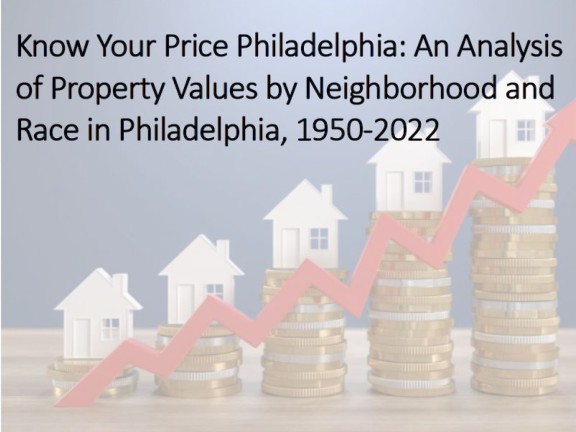Economy League Releases "Know Your Price, Philly"

What is the price of long-term racial inequity in Philadelphia’s housing market? Perhaps the most acute and impactful manifestation of structural racism is found in the real estate market. Due to a series of factors that research continues to reveal, such as historic redlining, bias in the mortgage lending system, and prejudice in contemporary assessment practices, properties within neighborhoods populated by people of color are continually assessed at lower values when compared to similar properties within predominantly non-Hispanic white neighborhoods.
Know Your Price, Philly, a new report from the Economy League of Greater Philadelphia in partnership with Dr. Kevin Gillen of Drexel University’s Lindy Institute and inspired by Dr. Andre Perry of the Brookings Institution, analyzes 70 years of property value data by race/ethnicity and neighborhood to quantify devaluation in Philadelphia.
Our analysis identified a $57 billion gap in appreciation values between properties in majority-white vs majority non-white neighborhoods. In sum, had houses in majority-Black neighborhoods appreciated at the same rate as houses in white neighborhoods (after inflation) since 1950, homeowners in Black neighborhoods would collectively have $24bn more in housing wealth; homeowners in majority-Latino neighborhoods would collectively have $33.4bn more in housing wealth.
Overview
For generations, the acquisition and accumulation of private property have long been a core element of “the American Dream,” where opportunity and initiative abound and upward economic mobility flourishes. Homeownership has been a primary vehicle for achieving this dream and building generational wealth.
Yet structural racism, in the form of slavery and its legacies, segregation, neighborhood redlining, racially restrictive covenants, and predatory lending, has denied the rising BIPOC majority in this country the full benefits of homeownership. According to a 2021 report from the Brookings Institution, the homeownership rate for white families is nearly 30% higher than for Black families. At the same time, recent data indicate the magnitude of the racial wealth gap in the U.S.: in 2016, white families’ highest median wealth was $171,000, as compared to $17,600 for Black families. The Brookings report suggests that maximizing both homeownership and home value are critical interventions for closing the racial wealth gap.
For a city its size Philadelphia has an unusually high rate of homeownership, still hovering above 50%. Yet the benefits of homeownership are not at all equitably distributed: many Philadelphia neighborhoods have experienced disinvestment and properties have devalued, often falling below the price of purchase in real terms. Devalued property is at the nexus of a host of inequities, such as public education funding, libraries, parks, public safety, and other neighborhood amenities, as well as access to capital to start and grow businesses or accrue intergenerational wealth. The devaluation of properties within neighborhoods of color is the longest tail of structural racism, a massive barrier to accessing the benefits of long-term property ownership, building generational wealth, and sustaining adequately resourced and economically resilient communities.
Inspired by the Brookings Institution’s Andre Perry, a leading scholar of the historic devaluation of Black property in the U.S., the Economy League will use its Impact Labs platform to pose the Fair City Challenge to Philadelphians: share your best ideas for revaluing property in historically undervalued neighborhoods and we will work to incubate, accelerate, and invest in the most impactful solutions.
READ THE FULL REPORT HERE
Watch the discussion w Andre Perry HERE
(Passcode: tY=+V0Mp)